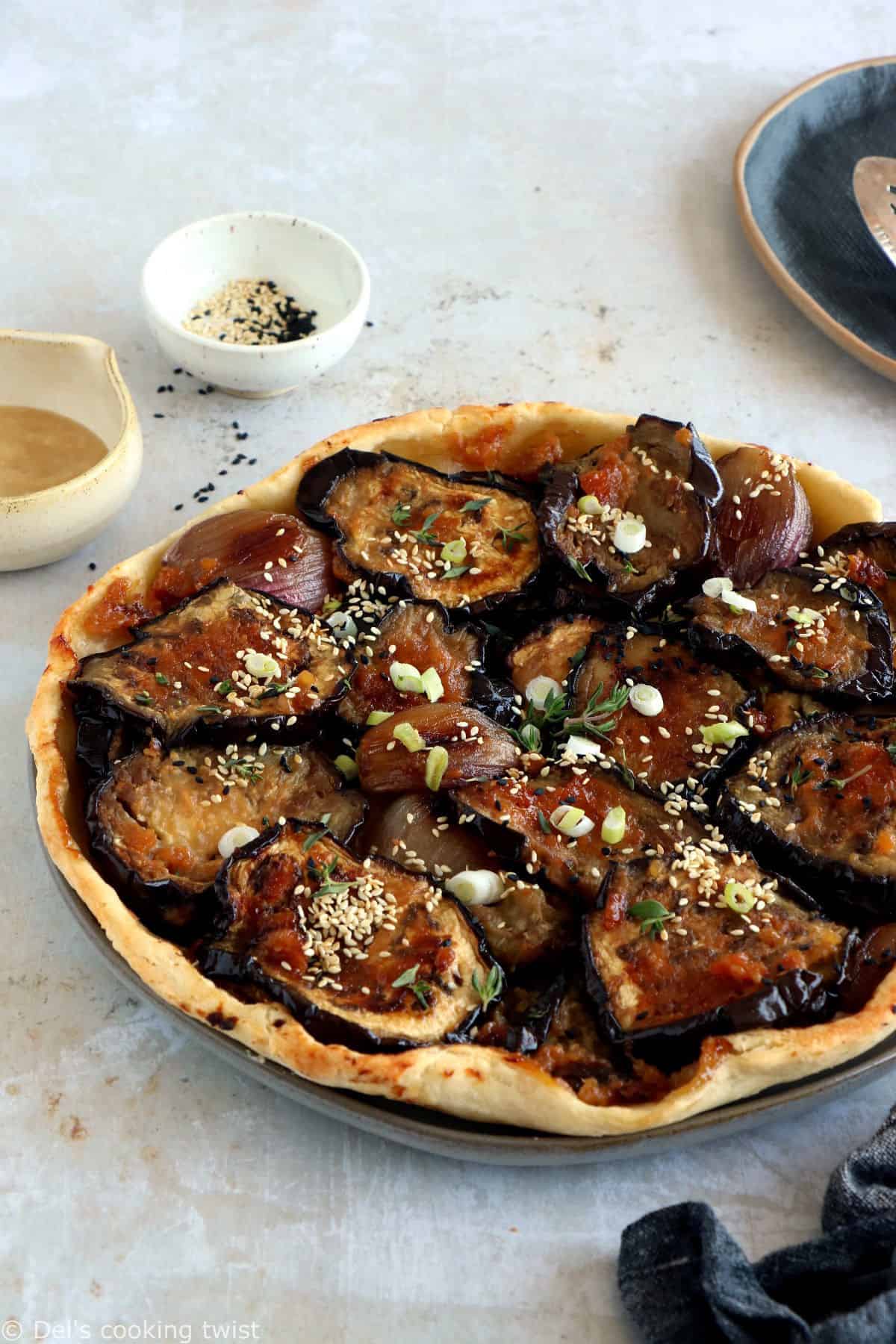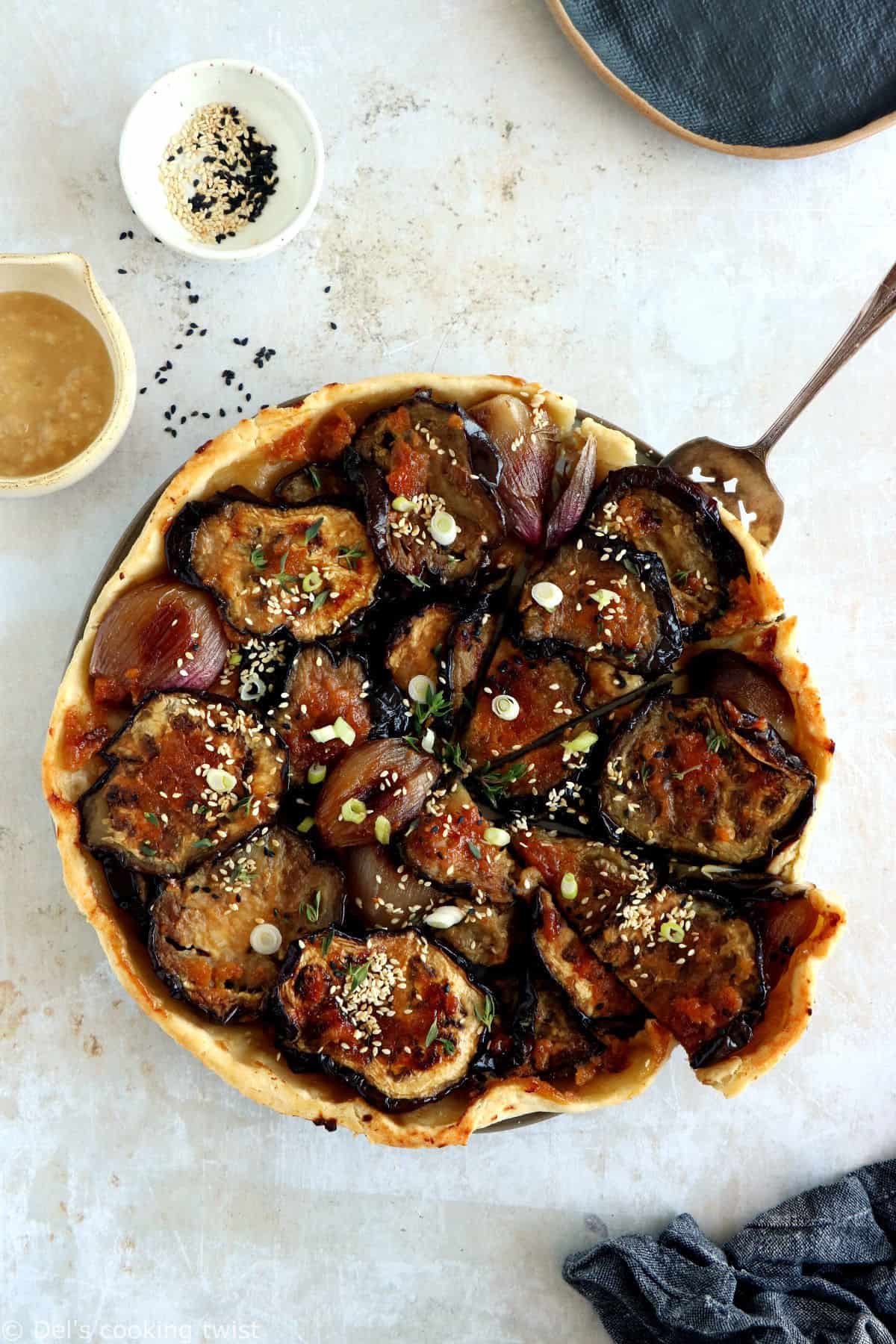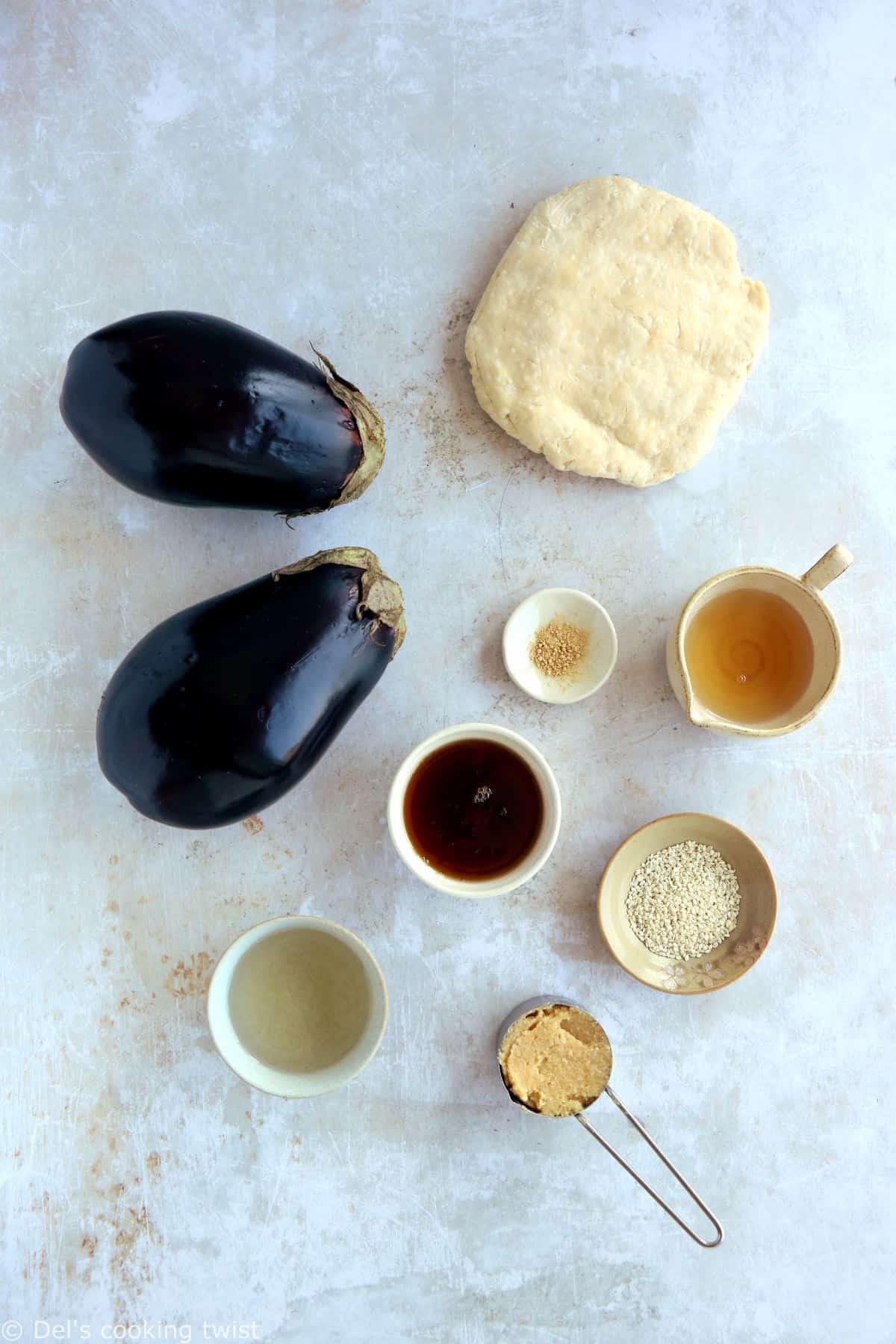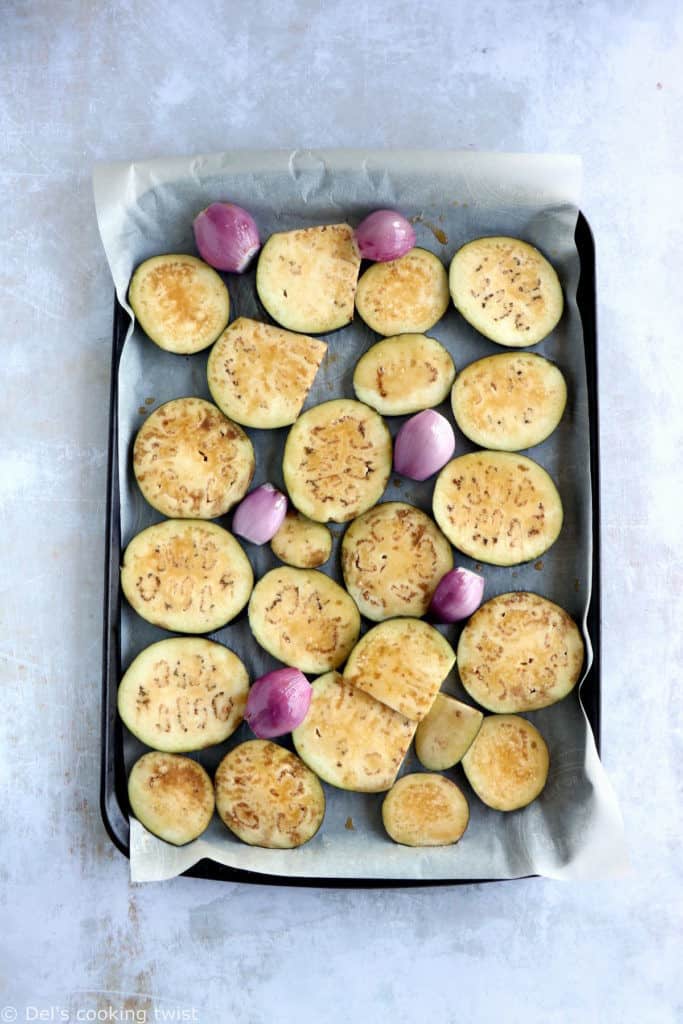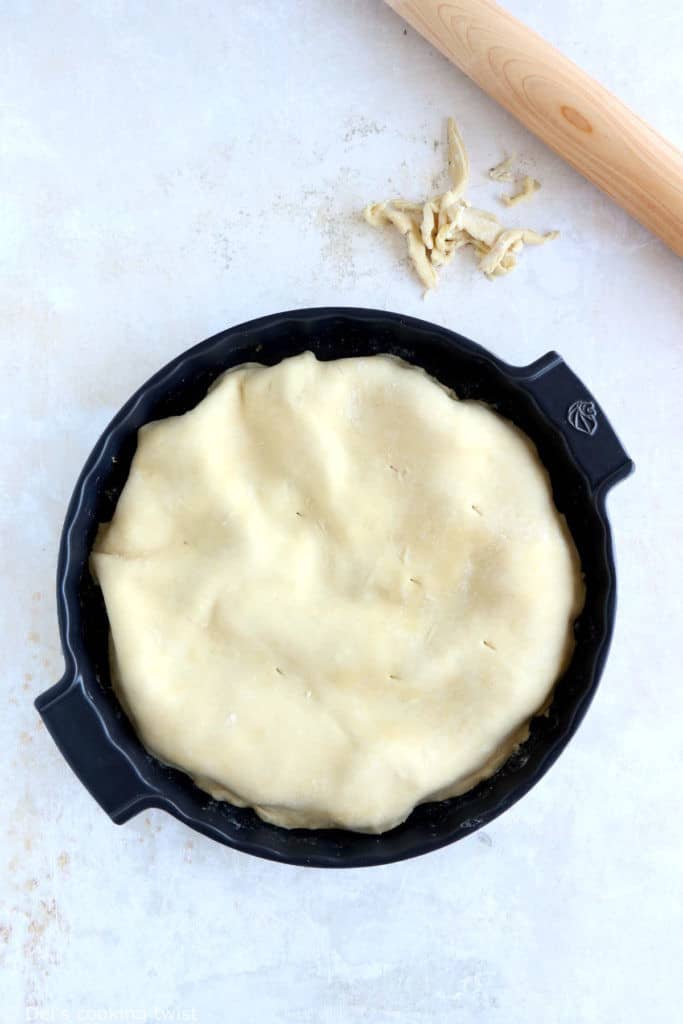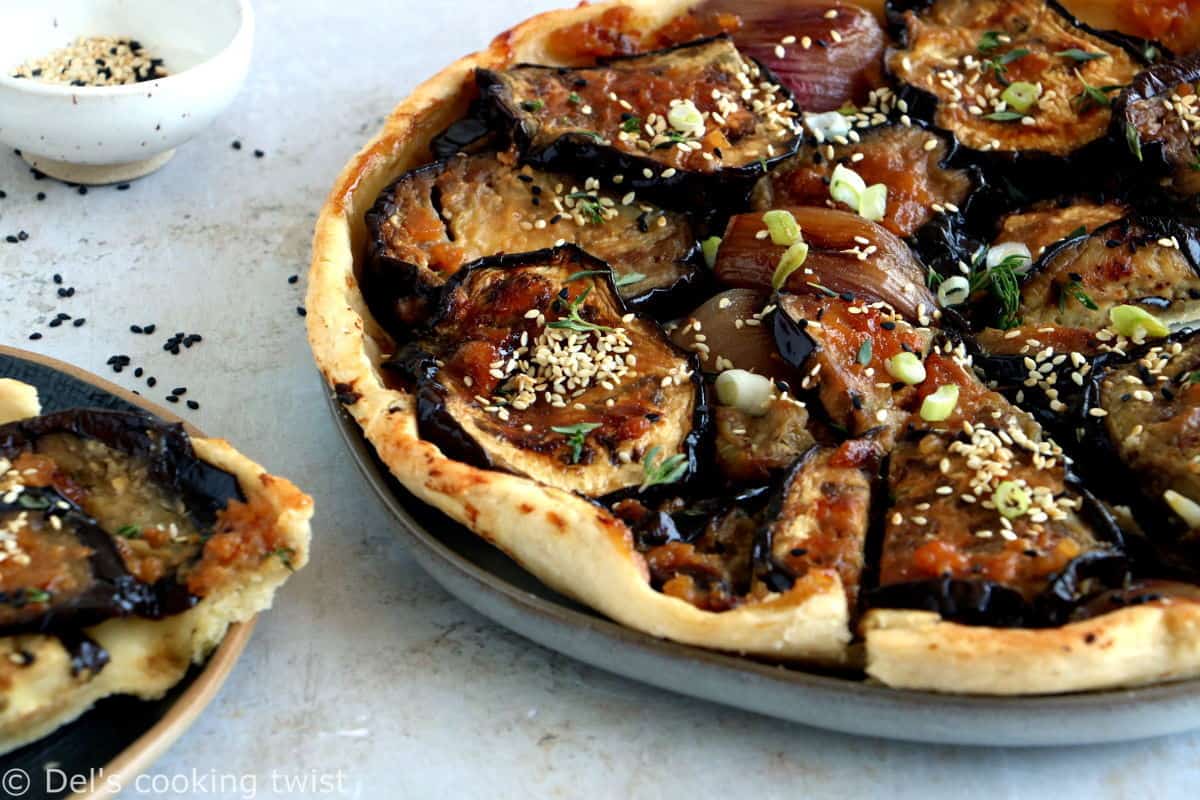You’ll fall in love with this incredible miso-glazed eggplant tarte tatin. Inspired from the traditional Japanese nasu dengaku recipe, it features some tender broiled eggplant slices brushed with a sweet miso glaze atop an inverted crust, French way. Fusion food has never been so delicious!

Email me this recipe
We’ll send it straight to your inbox, along with weekly food inspiration!
I’m seriously obsessed with miso-glazed eggplants! If you’ve never tried them before, they’re definitely to add on your to-do. They’re so easy to make, so tender, and packed with wonderful Asian-inspired sweet and sour flavors. It’s the kind of dish I could eat on repeat all summer and fall, or as long as eggplants are in season.
You could absolutely eat Japanese miso eggplants on their own (or with a side of rice). But for a more filling and sophisticated dish, why don’t you try fusion cooking and test this incredible savory miso-glazed eggplant tarte tatin? I’ve prepared various vegetable tarte tatin recipes before (like this goat cheese and red onion tarte tatin, or this caramelized root vegetable tarte tatin with feta) and I can assure you they never let your guests unimpressed. Oh, and I promise tarte tatin is way easier to prepare than it seems!
What is miso-glazed eggplant?
Miso-glazed eggplant (or Nasu Dengaku in Japanese) is a classic Japanese dish traditionally prepared with long and thin Japanese eggplants, sliced in half, scored and brushed with a sweet and savory miso glaze. The translation literally means eggplant grilled over a fire, which is exactly how it’s done in Japan. The flavor is savory, smoky and sweet, but also slightly toasted and nutty on the edges. SO good!
In my version, I used Italian eggplants (the round and large ones), sliced them, grilled them in the oven until tender. Then, I topped them with the miso glaze and finished under a broiler until the miso glaze caramelizes and bubbles.
Ingredients you need
- Eggplants. I used Italian eggplants in this recipe, although the traditional Japanase recipe is prepared with Japanese eggplants. Both options work, so choose your favorite (or what you have at hands).
- White miso paste. If you’ve never cooked with miso before and are a little bit unsure about the flavor, be reassured. This fermented paste adds a salty umami flavors to many Japanese dishes. In fact, my husband was not too sure about it until he tried – he got hooked at first bite. Miso paste is the secret ingredient of this fantastic dish!
- Sesame oil. Toasted sesame oil is beloved for its rich, nutty, toasty taste. It has a distinct toasted sesame aroma and adds a punch of flavor to recipes.
- Rice vinegar. Do not replace with any other vinegar, the rice vinegar is lightly sweet and sour, and particularly adapted in Asian cooking.
- Ginger. Try to use fresh ginger and grate it just before using. I didn’t have fresh ginger for the photo here so I used ground ginger. I then tried both options for this recipe: fresh ginger wins by far!
- Honey. You could also use agave syrup or even maple syrup if you wish.
- Black and/or white sesame. I used both, slightly toasted in a pan on high heat without any addition of fat.
- Pie crust. Please, make yourself a favor and use a homemade pie crust, it makes the whole difference. Alternatively, you can use puff pastry too!
How to make a miso-glazed eggplant tarte tatin?
So now that we know about Nasu Dengaku and have all our ingredients ready, let’s get started with this savory tarte tatin aka soon-to-be your new favorite summer recipe! Here’s how to:
- Start with making the pie crust, wrap it and let chill in the refrigerator.
- Then, place the eggplant slices onto a baking sheet, brush with oil and roast them in the oven.
- Cook up all the ingredients of the miso-glazed together in a saucepan, and set aside.
- When eggplants are ready, cover them with the miso glaze, reserving ¼ for later, and broil for just a few minutes, until slightly caramelized.
- To assemble the tarte tatin, spread the reserved miso-glaze at the bottom of the pie dish, display the eggplant slices on top, adding the halved shallots in the remaining holes. Pour the remaining miso sauce, then cover with the pie crust, tucking down the sides of the dish. Make a few slits, and bake!
Pro-tips for a beautiful miso eggplant tarte tatin:
- If you’re a beginner to tarte tatin (and even if you’re not), choose a nonstick pie dish. You’ll thank me later!
- When displaying the eggplant slices at the bottom of the dish, keep in mind that the tart will be inverted. This will help you make a lovely pattern.
- Make a flew slits in the dough with a sharp knife before baking, in order to enable the steam to escape while baking.
- Bake until the miso caramel underneath starts bubbling and the crust becomes slightly golden.
- To invert the pie, proceed in 3 steps: 1/ remove the tatin from the oven, 2/ let cool on the countertop for 5 minutes until it cools down a little (do not wait too long or the miso will stick to the bottom), 3/ Place a plate of similar size on top and invert the tart in one quick, confident move.
- If some of the vegetables or other ingredients stick to the bottom of the dish, lift them carefully with a spatula and place them back on the tart (keeping in mind that it is supposed to be inverted).
More eggplant recipes you’ll love:
- Baba Ganoush
- Eggplant Rolls filled with Hummus
- Quinoa-Stuffed Eggplants
- Easy Eggplant Chickpea Curry
- Eggplant and Goat Cheese Stacks
- Grilled Veggie Gyros with Feta Yogurt Dip
Other Asian-inspired dishes:
- Easy Vegan Pad Thai
- Thai Peanut Quinoa Salad
- Asian Tofu Brocoli Stir-Fry
- Vegan Thai Red Curry Noodle Soup
Miso-Glazed Eggplant Tarte Tatin

- Prep Time: 30 mins
- Cook Time: 30 mins
- Total Time: 1 hour
- Yield: 8 servings 1x
- Category: Savory
- Cuisine: World Cuisine
- Diet: Vegetarian
Inspired from the traditional Japanese nasu dengaku recipe, this miso eggplant tarte tatin features some tender broiled eggplant slices brushed with a sweet miso glaze atop an inverted crust, French way.
Email me this recipe
We’ll send it straight to your inbox, along with weekly food inspiration!
Ingredients
- 1 ready-rolled puff pastry (or butter pie crust)*
- 2 small eggplants, sliced into 0.4 inch (1 cm) thick
- 4 small shallots, halved
- ⅓ cup (80 ml) rice vinegar
- ¼ cup (70g) white miso paste
- 2 Tablespoons honey
- 1 Tablespoon fresh ginger, grated**
- 2 spring onions, thinly sliced
- Toasted white and/or black sesame, for garnish
Instructions
- Preheat the oven to 425°F (220°C) and line a large baking sheet with parchment paper.
- Place the eggplant slices and halved shallots onto the prepared baking sheet, and brush with sesame oil. Roast for about 15 minutes.
- Meanwhile, combine the vinegar, miso, honey, and ginger in a small saucepan. Bring to a boil over high heat and cook, stirring, for about 5 minutes, until smooth and combined. Remove the pan from the heat.
- Remove the eggplants from the oven, brush generously with three quarters of the miso glaze, then place back in the oven on broil position, and broil for about 3 minutes or until slightly caramelized.
- Lower the oven temperature to 350°F (180°C) and grease a 12-inch (30 cm) tart dish with butter. Set aside.
- Arrange the eggplants to the bottom of the tart dish (face with the miso glaze down). Add the caramelized shallots in the remaining holes, then pour the remaining miso glaze over.
- Roll out the dough into a disk slightly larger than the tart dish. Then, carefully lift the crust over the filling and tuck down the sides of the dish. Make two small slits for the steam to escape.
- Bake for about 30 minutes until the pastry is well risen. Leave to stand for five minutes. Cover the dish with a plate, invert, then remove the dish, leaving the tart now on the plate. Garnish with sliced spring onions, and sprinkle additional black and white sesame seeds on top.
Notes
* For homemade pie crust you will need 3.5 ounces (100g) diced unsalted butter, 1 ⅔ cups (200g) all-purpose flour, 1 pinch of salt, 5 Tablespoons cold water. Mix all the ingredients until they stick together and form a ball. Roll out the dough into a large disk, leaving a border a little larger than the tart dish.
** Or replace with 2 teaspoons ground ginger. Between both options, go for fresh ginger.
Did you make this recipe?
Lastly, if you make this Miso-Glazed Eggplant Tarte Tatin, be sure to leave a comment and give this recipe a rating, letting me know how you liked it. And of course, don’t forget to tag me on Instagram! Thank you and enjoy!
